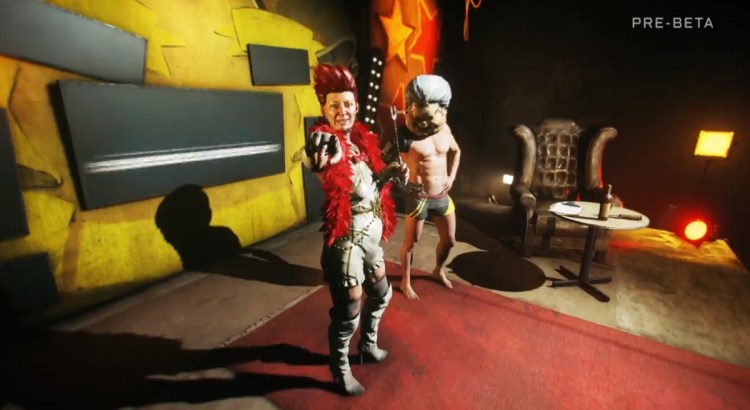I’d like to meet the artists at Avalanche Studios who came up with the crazy art of Rage 2. I can guarantee you that they’re nuts, because they have created a postapocalyptic world that is even more insane than the one from one of their prior projects, Mad Max. You have to wonder how they had the imagination to create Rage 2, at least until you meet Tim Willits.
Willits is the studio director at id Software, and he commanded them to honor one of his pillars for the game by writing on a whiteboard: “More crazy than Rage.” And that’s how id Software wound up with a game that has a far different tone from its prior games like Wolfenstein, Doom, Quake, and even the original Rage from 2011.
How crazy is it? It has so many colors mixed together that when you shoot someone up close with a shotgun blast, you can’t even tell the red blood spraying on the wall from all the other colors. We’ve seen some crazy shooters before like Saints Row, Far Cry 3: Blood Dragon, and Just Cause 4. It so happens that the latter game was made by Avalanche Studios, which is building Rage 2 for ZeniMax’s id Software. Rage 2 joins this happy genre on May 14 on PC, PlayStation 4, and Xbox One.
I played Rage 2‘s latest demo at an event in San Francisco, and then we talked. Willits did a short presentation and then opened it up for a Q&A with a group of journalists. (I’ve marked that part of the conversation with “question,” and my part of the interview is marked with “GamesBeat” queries). Has he lost it? Well, Willits may have indeed gone crazy to greenlight such a game. But then again, as a game developer who grew up at id Software making bloody shooter games, Willits may never have been sane in the first place.
June 5th: The AI Audit in NYC
Join us next week in NYC to engage with top executive leaders, delving into strategies for auditing AI models to ensure fairness, optimal performance, and ethical compliance across diverse organizations. Secure your attendance for this exclusive invite-only event.
Here’s an edited transcript of our interview.

Above: Tim Willits is studio director at id Software.
Tim Willits: There are two questions that everyone asked me. The first question is, “Why Rage 2?” and the second question is, “How is the relationship with Avalanche? How did that come together and how do you work together?”
To answer the first question, Rage has always had a special place in our hearts at id Software. Millions of people played it. It was well-rated. We always liked to bring our style of combat to an open world. But one of the problems with the original Rage was that the technology really limited us to not much of an open world. You had gunplay areas and driving areas and cities. You had level loading and switching disks. That was a nightmare. I like to say that mega-textures look pretty, but they weren’t great for actual gameplay. But we always wanted to come back to this world, because we love the open world style.
When Avalanche Studios, the Swedish studio, very famous for Just Cause and Mad Max — when that team wrapped up Max and there was an opportunity to work with them, we jumped on that opportunity. We’ve liked those guys for a long time, and they’ve liked us. What’s great about working with Avalanche is, they bring to the table the Apex engine. This is the Avalanche engine. It’s not id Software technology. They also bring the love and experience of creating these open world games.
What we bring, we have a lot of experience on hardcore first-person shooters. If you’ve played Doom 2016 when it came out, that pushed forward combat, excelled at combat. We’ve taken a lot of inspiration from that style of combat. You may not have realized this, but all the mechanics really do get you closer to the action, even though it’s a much bigger game. All of the active abilities really get you into the fight. Even the weapons — we don’t have a classic sniper rifle in this game. We reward you for getting into the action.
Avalanche, like I say, is the developer, but a number of people at id work with them every day. We have experts at id that have helped bring this id style of combat to the open world. It’s not like a block of code that we just check into their engine. It’s the knowledge of where the gun position should be, animation, speed, situational weapons, things like that. When we’ve had resources at id working on the game, they’ve come in and worked with the Avalanche team on the specific things they do really well.
We’ve learned a lot by working with the Avalanche team. Personally, I come from a level design background. I’ve always thought about levels where you have a beginning, a middle, and an end. Avalanche has taught me to think more about levels as areas you can approach in any way.
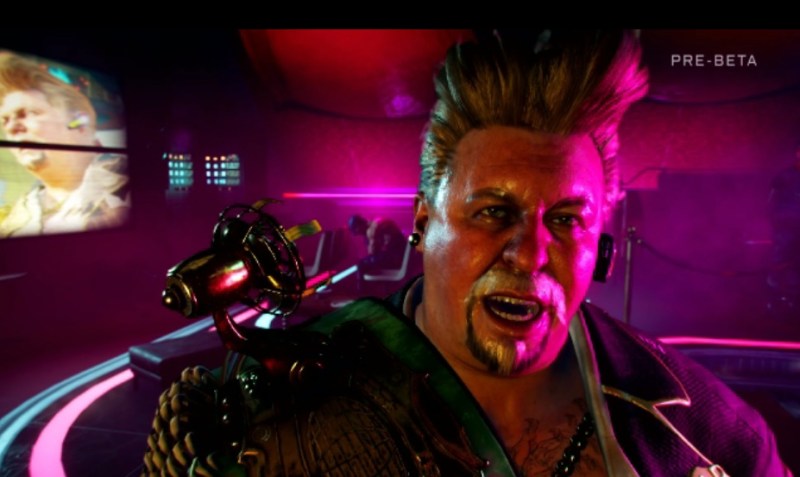
Above: Klegg Clayton has a fan on his shoulder.
Question: Compared to the original game, it feels like it has a much more over the top, bombastic, almost cartoonish theme running through it. Can you explain why you wanted to go in that direction?
Willits: Rage was very brown and drab. Mad Max was very brown and drab. When we got together, we opened the color wheel and said, “Wow, look at all these colors! This is amazing!” Like I said before, we wanted to set the world apart from the original. The engine has allowed us to create these biomes that bring much more richness to the environment, which then led to us creating characters that were brighter and more colorful. And then the vehicles and the architecture.
All that seeped into the tone and the personality of the game. We wanted to create a game that was fun. We don’t take ourselves too seriously. Sometimes game designers forget that games are supposed to be fun. By really setting the look and the colors and the tone apart from not only our own post-apocalyptic games, but we also have other post-apocalyptic games out there that exist in the space — it allows it to be refreshing. We can focus on the fun aspects of playing video games.
Question: Did you have a line where you thought, “We still want to retain some of that gritty feeling of the original and not go too far?” Or did you just want to go all the way there?
Willits: There is some — you’ve played it. There are some things that are a little dark-ish. But no, we had no official lines. When I met with the team in Stockholm, I wrote on the whiteboard, “MORE CRAZY THAN RAGE.” That was the first pillar of this game. The Avalanche team loved the fact that they could do whatever they wanted to. They were not constrained by some defined universe that they had to live in. That’s our mentality.
Question: How much story is there? Is that something that keeps pulling you in a particular direction?
Willits: Like I mentioned before, you as Walker, that’s a very classic story. But the bulk of the story really does come from Marshall and Loosum and Kvasir. You got a little bit there, the power struggle with Clayton and things. And then of course there’s the other characters in the world that you can talk to, and the environmental storytelling. But those characters really drive the story.
You, as Walker, you talk, which is new for us. A few people have told me that, when they first started playing and Walker talked, they thought, “What’s going on?” It threw them off. But we did that to help tell more of a story. We did that to help people who never played the first one — Walker will tell you what you need to know when you play. If you notice, sometimes Walker says things that you’re thinking, making fun of video game tropes. “I’m really supposed to stick my arm into this? I’m the only guy who can do this?” He helps push the story forward as well.
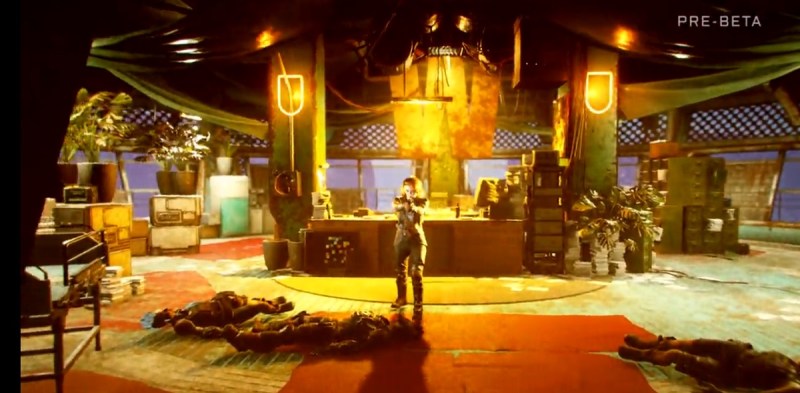
Above: Loosum Hagar is a fairly normal character in Rage 2.
Question: You brought up Doom, and I thought of that too when I was playing, but I think the thing that made Doom’s push-forward combat so good was the lack of reloading, always sprinting in every direction. This game doesn’t have that. How do you think that affects getting to the combat that you want?
Willits: We couldn’t re-create the exact same microcosm of action that we had in Doom. With the weapons and the reliability of the weapons we have, we wanted to keep reload in, so you can fight, fight, pace, reload, set up, and then re-engage. But with the abilities and rewarding people for quick kills, that does help you get into the action. When people play it, I’ve been very pleased when they come back and say, “Yeah, it feels like an id game, but it has all this other stuff.” Kind of like the love child of Avalanche and id.
Question: Was there any required reading or source that the development team had to take in for this?
Willits: When you play it, obviously, you can sense things in the world that are inspired. We get this question a lot. Rage, of course, was an inspiration. The games that Avalanche has done have been an inspiration. We’ve tapped into some of that ‘80s punk culture a bit. Some of the classic comic books, we’re all big fans. If you read the original Judge Dredd comics, you can see some inspirations there.
One thing we do try to do, though, is keep a flat enough design structure where everyone feels they can bring their own inspirations and desires into the game. The world is crazy enough, for lack of a better word, where we can bring stuff in from all over and it all just works.
Question: Not to only compare it to Doom, but did you ever feel like you were competing with yourself, in a way? You’d come up with design ideas and realize, you already did that in something like Doom?
Willits: It’s always a fine line. You want every game to be unique, but then for id games, we like to have that DNA that flows through them. You can pick them up and play them and it feels like an id game. There are some mechanics that have naturally evolved into our games. We have double jump here, and we had double jump in DOOM, for instance. If you watch the DOOM stuff we showed at QuakeCon, and then play this, it looks a bit similar. But they have unique personalities and unique styles. There’s enough difference that they stand on their own.
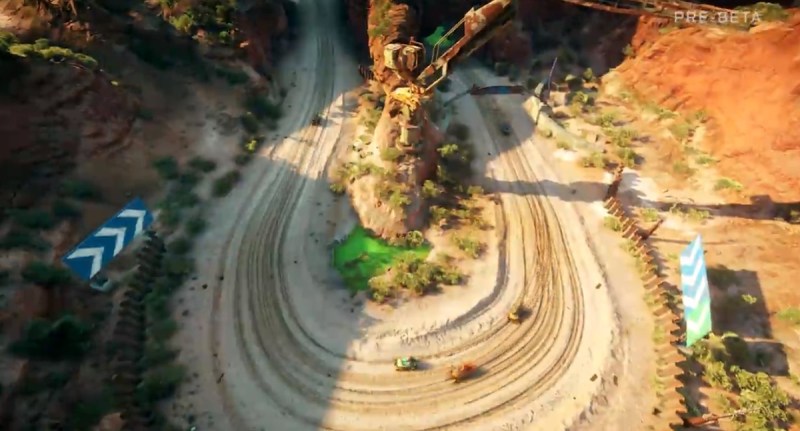
Above: Rage 2 features car combat after the apocalypse.
Question: Is this Avalanche’s engine entirely, or is it a shared code base?
Willits: No, there’s no id Software technology in this game. But again, a lot of the lessons we took away — there is no cover mechanic for you as a player, but the enemy does take cover. When you shoot them and they get back up, that was a signature component of the AI in the original, and we brought that back. Knocking the armor off some of the beefier enemies, that was a signature piece in the original. We tried to bring that back in.
Question: When it got more crazy, it also got more like Just Cause. Did you want to avoid comparisons to things like that?
Willits: It’s hard to make a franchise for so many years and not have inspirations come from there. I’ve always been a big Just Cause fan. That’s the Avalanche style. I tell the guys sometimes, “More exploding barrels! More stuff that swings and breaks and blows up and falls over! That’s the Avalanche thing.” I’ve actually pushed them more toward the Avalanche style, because it’s just fun. There is no wingsuit, though, and no grappling hook.
Question: What is a Nanotrite?
Willits: You didn’t play the original, did you? [laughs] That’s okay. Let me back up into the fiction. When the asteroid was going to hit the earth, mankind started the Eden Project. We froze people in arks underground, and then we put nano-robots inside the systems of the people who were frozen. The idea was that the nano-robots would heal you and help you survive in a post-apocalyptic world.
This technology has advanced, and the Authority and scientists from the Eden Project learned how to manipulate and enhance the Nanotrites. That led to using them as the fiction behind what you can do in the game.
Question: It’s always hard to tell in open world games, but do you have an estimated play time for the game?
Willits: I get that question a lot. People are spending longer, even on this small section of the game. You all spent much longer than I originally thought anyone would, which is good. But we haven’t really had testers starting from the very beginning with as much time as they want to go play. So I know this sounds cagey, but we haven’t gone through that exercise yet.
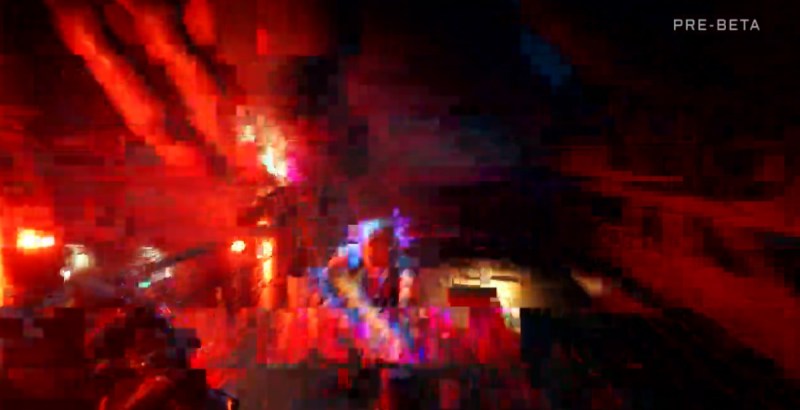
Above: A freeze frame from a screen in Rage 2.
Question: Do you have any PvP plans for the game?
Willits: It’s a single-player game. We will have a few community things, but we’ll be talking about those later. We feel that we’re offering great value in this game, and it’s only single-player. We will have some free updates and some paid updates. We want to extend the tail of the product.
Another question I get a lot is on systems and platforms. What’s the difference between the game on the Xbox One and Xbox One X? We went with speed over 4K. On the PS4 Pro and Xbox One X, the faster consoles, it’ll run at 60fps. On the slower consoles it’ll run at 30fps. On PCs it’ll run as fast your system lets it, and it’ll run in 4K, of course. You were playing on PC today. I think they were just 1080s.
Question: Have you considered co-op play at all?
Willits: We’ve talked about that a lot. People love playing with their friends. As game developers — and Todd Howard is famous for saying this, so I’ll steal his line — we can do anything, but we can’t do everything. For us, we wanted to focus on core combat. We wanted to focus on a really great world. That’s where we ended up. But it would be cool, and we have talked about it.
Question: There’s a ton of open games out there, especially within the last year. How do you differentiate yourself? How did you set out to do that?
Willits: The biggest thing about creating a post-apocalyptic world — I like to say this is post-post-apocalyptic — I hope you experienced this when you played. The personality is different. We’ve tried to add more color and vegetation. People aren’t starving. There’s water. What does the world look like after the dust settles?
Rage took place 100 years after the asteroid hit, and this takes place 30 years after that. The world is greener. If you go from Wellspring to Gunbarrel to Lagoona, you can see how people look different, what they wear. We really tried to give it more personality. We tried to make the game look fun. It’s the action side, the lighter side of surviving in this world. I hope that personality has come through as why this is a different kind of post-apocalyptic game.
If you sit and play for a few hours, put the controller down, laugh a little, smile — if you had a good time and blew some guys up — that’s what we want.
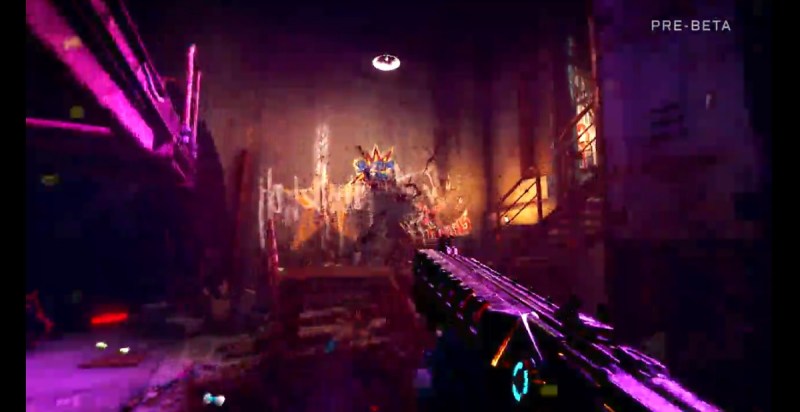
Above: Somewhere, there’s a blood splatter here in Rage 2.
Question: Do you have anything you can say about the Nintendo Switch? Or VR?
Willits: We have looked at the technology, but we’re still evaluating our plans on the Switch platform. Same with VR. We’re just trying to get the game done now. May is coming quick. We need to polish it up.
Question: Any tips for killing the really big enemies?
Willits: Dash and Overdrive. Overdrive with the machine gun is more effective against bosses than Overdrive with the shotgun. You have to set up that rhythm. Dash, shoot, dash, Overdrive. More dashing, less slamming.
Question: I tried to attack the Ark Tower thing.
Willits: Those are tough!
Question: I wasn’t doing any damage to it at all.
Willits: When they open up, there’s the core. You take on the core and there are three levels that show up. But those are tough. And there’s still some balancing to be done. Our thinking is, we want players to explore. If they get into situations where they feel like it’s too tough, they can come back. You go get beefed up, come back, and kick ass.
Question: I saw some custom weapon mods and things like that. Is there a system for that in place that we weren’t able to get to in the demo?
Willits: Yes. You’ll be able to upgrade your weapons. I have a quick little list here of the sheer volume. There are over 70 projects. There’s eight weapons with mods. There’s the Nanotrite upgrades, the support upgrades, the vehicle upgrades. There are more of those tabs than we wanted to have in the demo today.
Question: How many of the different vehicles can you use?
Willits: It may have been a little hard to understand in this build, because the garage tab was disabled. Anything that you steal and drive back to Wellspring or Gunbarrel or the other cities — if you have the garage project enabled, you’ll be able to spawn any vehicle you steal anywhere in the wasteland. If you steal the monster truck and drive it back to your garage, you’ll be able to bring up your garage, select the monster truck, and drive it.
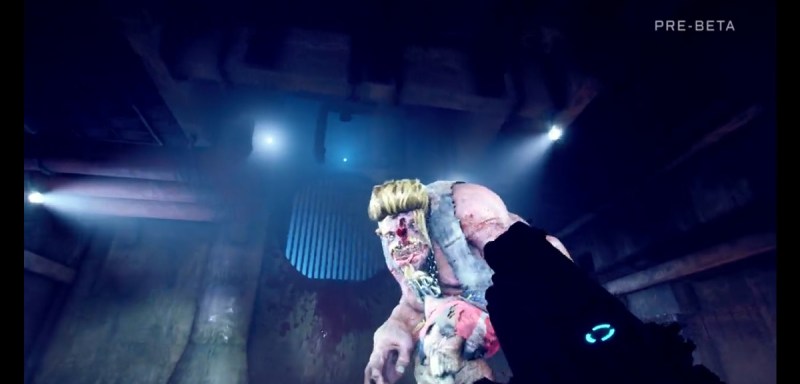
Above: Even a boss has crazy colors in Rage 2.
Question: What happens if they get destroyed?
Willits: There’s a salvage value for bringing them back, and then they come new, which is nice.
Question: What about microtransactions?
Willits: There are no loot boxes! [laughs] We’re working on those plans. But we want to keep — we’re trying to arrange our post-launch plans in such a way where we can be flexible enough to steer into what people like. A lot of times developers lock in their post-launch plans so far before the game ships, and then when the game ships they find out, “Oh, everyone likes red and we’ve made all this blue.” We’re trying to be flexible enough. There’s so much to do that we want to make sure we give people more of what they want.
Question: I know you said that this a stand-alone story and you don’t need to know what happened in the first game, or it’s more or less explained. Do you have any kind of intro video or other primer on that, though?
Willits: We do have an intro video, which roughly tells you what happened. Like I said, Vineland, the area where you grew up that gets attacked, that’s really your tutorial. We’ll introduce you to a number of characters. They’ll explain things. Walker does a lot of chatting while you learn the mechanics of the game. You’ll get a better understanding. Here you were just thrown in, so that was a little more challenging. But sometimes we overexplain things. You’ll have no problem.
GamesBeat: I had a harder time with some things. Turning the buggy was tough.
Tim Willits: Was it the braking or the turn radius?
GamesBeat: The turn radius, I think.
Willits: Do you feel it was too small or too big?
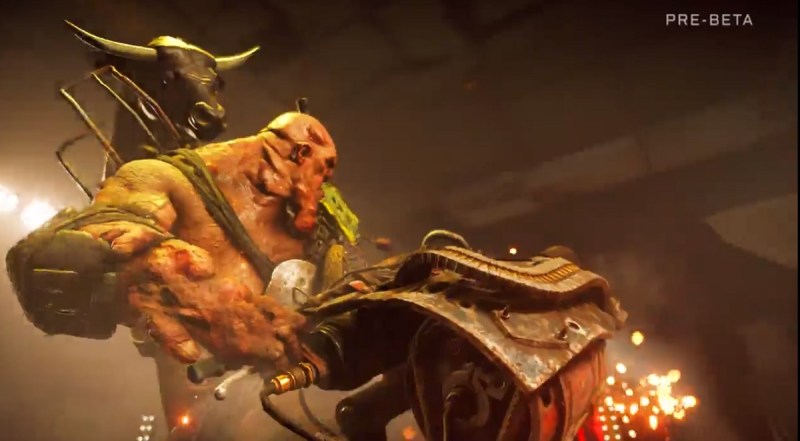
Above: Mutant Bash TV boss.
GamesBeat: I was sort of deceived by some of the turns. I could really hug the corners and turn like that. But with a different kind of momentum behind me, I’d go really wide and crash into the wall.
Willits: The braking distance in this build is actually much longer. I actually had them pull it back a little bit, because when you get up to top speed, it takes so long to brake. You smash into things, especially in the race. I had them increase the braking efficiency.
GamesBeat: But you do want us to brake, right? You have to brake a lot.
Willits: Yeah, you want to brake. Also, if you hit the handbrake, you can swing your back end out, and then when you hit boost, you go straight. That’s the opposite of reality. In reality, if you hit boost, your back end would just swing out even more. But when people see that kind of thing in action movies they think that’s how cars work. It’s more like Mario Kart. [laughs] In the updated build, we have better braking, which may help you.
GamesBeat: I may have relied too much on the ground-pounding thing, especially in the mutant area. It seems like it works really well against the mutants.
Willits: Yes, it’s more effective against the mutants, because they’re lighter. It doesn’t do a ton of actual damage. It has a lot of knockback, but it doesn’t do a lot of damage. On the mutants, because their health is so low, it does knockback and damage, so it’s more effective against them. Also, the shatter — if you don’t practice a lot, you don’t know the distance. Sometimes you may shatter and not actually do that much damage to somebody.
GamesBeat: It really does make sense to master the different abilities and know when to use them before you go out and start….
Willits: Especially against the turrets. The turrets are tough.
GamesBeat: When you came by, I wasn’t sure why the path on the map wasn’t spelled out for me.
Willits: Yes. That’s broken. Sometimes they don’t appear. That’s just a bug. And then when I redid the path, untracked and retracked, then it drew. That wasn’t your fault.
GamesBeat: So that’s what you want to happen. If you want to do the next mission, you should be able to find it quite easily?
Willits: Oh, yes. Always a track. There will always be a track.
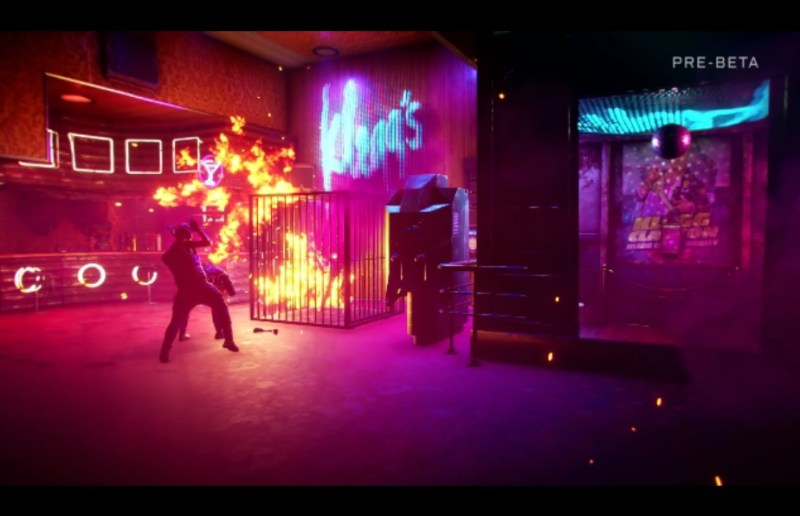
Above: Somebody is burning and screaming in Rage 2.
GamesBeat: I think that’s a good thing. In Red Dead 2, I always knew where to go next. Here’s the yellow path.
Willits: Nobody wants to be lost. That’s never fun.
GamesBeat: And then it seems like you’re almost encouraging us to stop halfway there and shoot a bunch of things.
Willits: Yeah, there’s a high distraction factor. The more you stop, and the more things you do, the more project points you’ll earn, and the more stuff you can unlock. The game is more fun that way. If you rush through the game — if you go do all the missions and you skip everything else — you won’t have as much stuff to fight. And like you said, once you figured out the ground slam and things like that, you had more fun. That’s when the game gets fun. We made it more dense so you get pulled off, and to reward you naturally, so when you do the main missions, you have more fun.
GamesBeat: How plentiful are things like the rockets going to be? When I was chasing one of the first cars, I wasn’t shooting very accurately with the rockets and I used them all up. I didn’t realize they were going to be so expensive and rare.
Willits: You’ll get better. [laughs] Also, did you talk to the little guy driving around in the van? He sells rockets and ammo for your vehicle. We’re doing our pricing and economy balancing now.
GamesBeat: In some ways unlimited rockets would feel like an id thing.
Willits: [laughs] What you can do, if you unlock the garage expansion project, you can steal cars. You spawn a bunch of bandit cars, those will have a bunch of ammo and you don’t have to worry about it. That’s a kind of workaround, almost a cheat, which is funny.
GamesBeat: I felt like there was a Call of Duty feel to some of the moves. The ground pound, the shield.
Willits: There are general advancements in games, things that just appear and happen through the natural evolution of gameplay. Plus, we’re all game fans. We all play everything.
GamesBeat: With the wingsticks, I remembered that you shouldn’t throw them at anything where there’s a metal barrier.
Willits: Right, it’ll break.
GamesBeat: Or you shouldn’t throw it at a guy with heavy armor.
Willits: Yes, yes. You can do damage, but you’ll need to upgrade it. You should have a clear line of sight. Unless you spend a project point and get the ability to lock it on.
GamesBeat: They’re really good, but you shouldn’t waste them.
Willits: Right. You need to be smart with those.
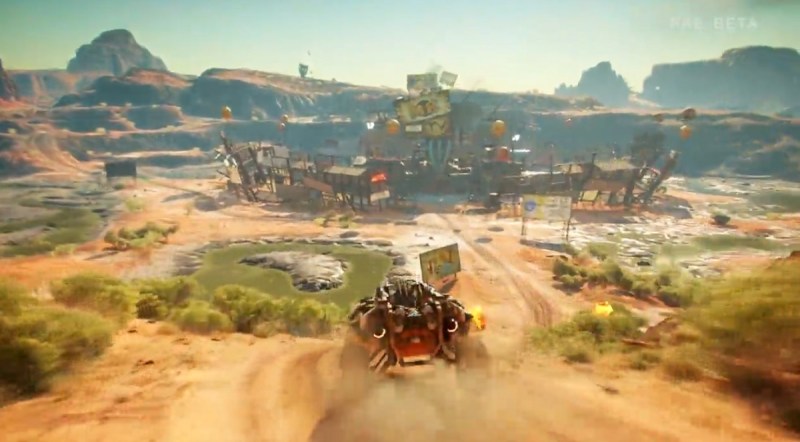
Above: You can kill mutants in a game show in Rage 2.
GamesBeat: I was remembering how that was my favorite thing in the first game.
Willits: The wingsticks were awesome, yeah. It was the signature piece.
GamesBeat: As far as beefing up your vehicle, have we seen much of that?
Willits: We had the garage tab turned off, yeah. But it’s just a Phoenix. There’s four weapons: the mortars, the rockets, the gatling guns, the machine guns. You have a more powerful engine. You can do that energy attack. Those all upgrade.
GamesBeat: Is it more like Mad Max, armoring your car up and things like that?
Willits: Not really. It’s already pretty beefy. There’s a few upgrades, but it’s not about tricking it out with hundreds of upgrades. It’s not like that.
GamesBeat: It seems like, in some ways, you’re economizing. You’re not going completely crazy in some of these areas.
Willits: Yeah, because it’s overwhelming. Theoretically we could have hundreds or thousands of upgrades. But that’s just not the premise of the game.
GamesBeat: What did feel like it was important for you to get right?
Willits: To make the combat fun, the gunplay. We really wanted it to feel like an id game. Being able to use your combos, get that dance of death going, get the right weapon for the right situation. We wanted that. That’s the core of the experience. Everything else supports that. There’s other fun stuff to do. Racing is fun. Mutant Bash is fun. Stealing all the vehicles and taking them back to your garage is fun. But I want people to really enjoy the combat. That’s the id Software thing to say.
GamesBeat: If you go in just shooting one weapon against a bunch of these things, you’re not going to survive.
Willits: Yeah, you’re not going to do very well.
GamesBeat: But if you use all these different things….
Willits: When we were first testing the game, and we weren’t introducing people to learning how to use the abilities yet — we were just giving them the abilities and letting them play — they didn’t know they should use them. They’d just use the guns and they’d say, “It’s too hard.” But when we had the little virtual training areas where they’d learn how to use everything, when they went back to play the same areas they’d have more fun. It wasn’t so hard, because they’d learned to use everything in the arsenal.
GamesBeat: Have you thought about something like a quick menu that reminds you of everything?
Willits: It’s a hard one. They’re on the screen. The Overdrive that lights up, people still miss that. It just takes practice.
